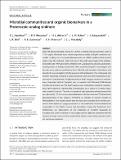Microbial communities and organic biomarkers in a Proterozoic-analog sinkhole
Author(s)
Hamilton, T. L.; Welander, P. V.; Albrecht, H. L.; Fulton, J. M.; Schaperdoth, I.; Bird, L. R.; Freeman, K. H.; Macalady, J. L.; Summons, Roger E; ... Show more Show less
DownloadHamilton_et_al-2017-Geobiology.pdf (1.026Mb)
PUBLISHER_CC
Publisher with Creative Commons License
Creative Commons Attribution
Terms of use
Metadata
Show full item recordAbstract
Little Salt Spring (Sarasota County, FL, USA) is a sinkhole with groundwater vents at ~77 m depth. The entire water column experiences sulfidic (~50 μM) conditions seasonally, resulting in a system poised between oxic and sulfidic conditions. Red pinnacle mats occupy the sediment–water interface in the sunlit upper basin of the sinkhole, and yielded 16S rRNA gene clones affiliated with Cyanobacteria, Chlorobi, and sulfate-reducing clades of Deltaproteobacteria. Nine bacteriochlorophyll e homologues and isorenieratene indicate contributions from Chlorobi, and abundant chlorophyll a and pheophytin a are consistent with the presence of Cyanobacteria. The red pinnacle mat contains hopanoids, including 2-methyl structures that have been interpreted as biomarkers for Cyanobacteria. A single sequence of hpnP, the gene required for methylation of hopanoids at the C-2 position, was recovered in both DNA and cDNA libraries from the red pinnacle mat. The hpnP sequence was most closely related to cyanobacterial hpnP sequences, implying that Cyanobacteria are a source of 2-methyl hopanoids present in the mat. The mats are capable of light-dependent primary productivity as evidenced by13C-bicarbonate photoassimilation. We also observed13C-bicarbonate photoassimilation in the presence of DCMU, an inhibitor of electron transfer to Photosystem II. Our results indicate that the mats carry out light-driven primary production in the absence of oxygen production—a mechanism that may have delayed the oxygenation of the Earth's oceans and atmosphere during the Proterozoic Eon. Furthermore, our observations of the production of 2-methyl hopanoids by Cyanobacteria under conditions of low oxygen and low light are consistent with the recovery of these structures from ancient black shales as well as their paucity in modern marine environments.
Date issued
2017-10Department
Massachusetts Institute of Technology. Department of Earth, Atmospheric, and Planetary SciencesJournal
Geobiology
Publisher
Wiley Blackwell
Citation
Hamilton, T. L. et al “Microbial Communities and Organic Biomarkers in a Proterozoic-Analog Sinkhole.” Geobiology 15, 6 (October 2017): 784–797 © 2017 The Authors
Version: Final published version
ISSN
1472-4677
1472-4669